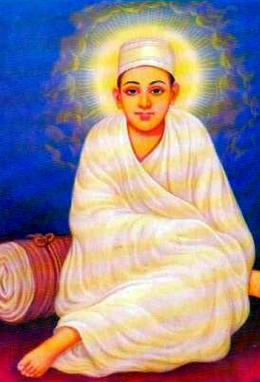Top Qs
Timeline
Chat
Perspective
Dadu Dayal
Indian saint From Wikipedia, the free encyclopedia
Remove ads
Dadu Dayal (Devanagari: दादू दयाल, Saint Dādūdayāl, 1544–1603) was a poet-saint religious reformer who spoke against formalism and priestcraft, and was active throughout Rajasthan.
This article has multiple issues. Please help improve it or discuss these issues on the talk page. (Learn how and when to remove these messages)
|
Remove ads
Etymology
"Dadu" means brother, and "Dayal" means "the compassionate one".[2]
Life
Summarize
Perspective
There are three main hagiographies on Dādū Dayāl. The Dādūjanmalīlā was written soon after Dādū Dayāl's death by his disciple Jangopāl, and Bhaktmāl was written by Rāghavdās in 1660. There exists a text entitled Sant gun sāgar purportedly written by Mādhavdās during Dādū Dayāl's life, however this is inauthentic and the text in reality likely dates to the early 19th century.[3]
Dādū Dayāl was born into the Piñjārā/Dhuniyā caste, but later sources attempted to portray him as a Brahmin. According to Jangopāl, he was born in Ahmedabad. However, other sources do not attest to this, nor did Dādū Dayāl have any impact on the city during his lifetime. Dādū Dayāl claimed to have received visions from his mystical guru, Bābā Būḍhāu, at the ages of 11 and 18.[3]
In 1573, his son, Garībdās, was born in the town of Sambhar, Rajasthan. His later children include Maskīndās, Havā, and Bāī. According to Jangopāl, his children were born without sexual intercourse with his wife. However, according to Rāghavdās, they were merely his first four disciples.[3]
In Sambhar, Dādū Dayāl claimed to hold debates with orthodox religious figures, and preached a "middle path" between various sects. By 1579, Dādū Dayāl and his four children/disciples moved to Amber. According to the Dādu panthī tradition, Dādū Dayāl visited the court of Akbar on the invitation of Bhagavantdās, Kachvāhā ruler of Amber. He then became increasingly nomadic. He moved to Karaṛālā, Naraina where he received land.[3]
In 1603, Dādū Dayāl died. His body was left in the wilderness, instead of being cremated or buried as per Hindu or Muslim tradition.[3]
Remove ads
Dadupanth
Summarize
Perspective

Dadu Dayal later moved to Naraina, near Jaipur, Rajasthan, where he gained a group of followers, forming a sect that became known as the Dadupanth.[4][1]
Dadupanthis are one of the 7 martial akharas of Vaishnavite sampradaya of Hindus.[5] Vaishnavism has following four major sects:[6]
- Sri, founded by Ramananda. Dadupanthis are one of those 7 martial akharas of Vaishnavite in the sect of Ramanada.
- Brahma. founded by Madhava.
- Ridra, founded by Vishnusuvamin
- Sanakadi, founded by Nimbarka.
Followers of Vaishnavism are also called Bairagi or Vairagi. Among the Bairagi, those who became part of the military akharas were organised in the 7 akharas, of which the founding dates are unclear. Each of the akharas accepted members from all 4 sects of Vaishnavism. Bairagi military akharas generally did not follow the prohibition against eating meat or taking narcotics.[6]
Dadu Anubhav Vani
Dadu's compositions in Braj language were recorded by his disciple Rajjab and are known as the Dadu Anubhav Vani, a compilation of 5,000 verses. Another disciple, Janagopal, wrote the earliest biography of Dadu.[4][7] Dadu alludes to spontaneous (sahaja) bless in his songs. Much of the imagery used is similar to that used by Kabir, and to that used by earlier Sahajiya Buddhists and Nath yogis. Dadu believed that devotion to God should transcend religious or sectarian affiliation, and that devotees should become non-sectarian or "Nipakh".[8] He said the following about that:[9]
So kāfir jo bolai kāf;
dil apna nahim rakhe sāf...
Translation:
The infidel is one who tells a lie;
One whose conscience isn't
clear...
Dadupanthi Thambas
Dadu had 100 disciples that attained samadhi. He instructed additional 52 disciples to set up ashrams, 'Thambas' around the region to spread the Lord's word.
Dadu spent the latter years of his life in Naraiana, a small distance away from the town of Dudu, near the city of Jaipur.[10]
Five thambas are considered sacred by the followers: Naraiana, Bhairanaji, Sambhar, Amer, and Karadala (Kalyanpura). Followers at these thambas later set up other places of worship.
Dadupanthi Martial Akharas
Armed martial akharas were first likely formed by the Dadupanthi Guru Jait Sahib (1693–1734 CE) when he recruited armed Naga sadhus. In 1733, Dadupanthis were tax paying farmers in Jaipur State, and martial Naga Sadhus were employed to enforce the payment of taxes. In 1793, Dadupanthis and Jaipur State had an agreement under which Dadhupanthis provided 5000 armed soldier sadhus to defend the Jaipur State. During the 1857 rebellion, Dadupanthis acted as mercenaries who helped the British Raj.
Prominent Dadupanthis
Present status
Dadupanth has continued in Rajasthan to the present-day and has been a major source of early manuscripts containing songs by Dadu and other North Indian saints.[4]
Remove ads
See also
- Akhara
- Bhakti movement
- Sampradaya
- Vaishnavism sampradaya
- Shaivism sampradaya
- Dashanami Sampradaya, a sub-sampradaya of Shaivism
References
Sources
External links
Wikiwand - on
Seamless Wikipedia browsing. On steroids.
Remove ads

